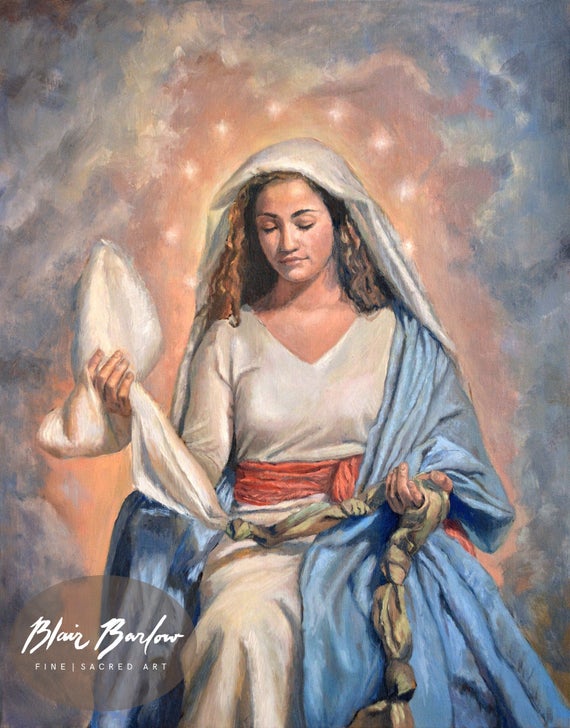About a year ago, a friend asked me to write about Mary and why Apostolics (Catholics and Orthodox) have such a unique affinity for the Mother of God (Theotokos). So I am now acting upon that request! This article is not meant to seek to prove why one (or any) devotion to the Blessed Mother is good and holy, but simply to reflect on the history of Early Christian attitudes towards Mary and present some current day examples of Marian devotion. While I hope to encourage all readers in a greater appreciation for Mary and her unparalleled role among the body of believers, this piece is meant as clear presentation of why Apostolics hold her in *such* high esteem.
Let us begin with some history. In his book “Mary in Early Christian Faith and Devotion,” Stephan J. Shoemaker argues against many Protestant and Catholic scholars to say that:
“[Mary] was effectively a saint among other saints who was revered for her exceptional purity and holiness as well as her intimacy with her son, a much more modest status that she retains, more or less, in much of the Christian East up until the present day. . . . Her veneration and intercession were not different in kind from that of other saints, but rather in quality.”
The Protevangelium of James is the oldest work in which some of the first Marian devotion can be clearly identified.* The Protevangelium is estimated by scholars to have been written in 145 AD and is the oldest source to assert the perpetual virginity of Mary. The Protevangelium elaborates the infancy narrative seen in the Gospels with a greater attention devoted to Mary. The author of the work self identifies as James (called brother of the Lord in scripture). While councils of the Church have held the work as inauthentic, it demonstrates a view of Mary that existed in the Early Church. Throughout the work it is clear that the author envisioned Mary as being especially prepared by God to be exceptionally holy, in a similar way to that of the Temple which held the Arc of the Covenant.** The first lines of the Protevengelium demonstrate Mary’s holy nature as the vessel that bore Christ:
“The Birth of Mary the Holy Mother of God, and Very Glorious Mother of Jesus Christ.”
Hardly a phrase you hear often in Protestant circles! Other texts which emphasized the significance of Mary came after the Protevengelium, but it was not until the council of Ephesus (431 AD) that her role was officially recognized by the Church. At the council, Mary was officially given the title “Mother of God.” Over time, in the Catholic and Orthodox Churches, reverence for Mary would develop and grow into a variety of different practices and theological beliefs.
As time went on, the practices of honoring Mary began to take a more definite form in the authority structure of the Apostolic Church. In the West, the call of the Archangel Gabriel to Mary, “Hail (Mary) full of grace, the Lord is with thee, blessed art thou amongst women,” forms the basis of the Catholic Hail Mary Prayer. Among both Catholics and Orthodox Mary became understood to be an intercessor whose acceptance of God’s Son into her womb paved the way for the salvation of all mankind.
These Marian devotions continued to take different forms through the Rosary, the Angelus, the Scapular, among others. In Romance nations in particular, these devotions tended took flowery, arguably excessive, language. For instance in the Salve Regina prayers, the Mother of God is referred to as, “Our Life, Our Sweetness, and Our Hope.” On theological grounds this is clearly heretical as only Christ should be these things to us. However there are many, including myself, that argue the flowery language is meant less as a theological treatise but as an expression of human emotion. St. Henry Newman writes:
So it is with devotional feelings. Burning thoughts and words are as open to criticism as they are beyond it. What is abstractedly extravagant, may in particular persons be becoming and beautiful, and only fall under blame when it is found in others who imitate them. When it is formalised into meditations and exercises, it is as repulsive as love-letters in a police report. Moreover, even holy minds adopt and become familiar with language which they would never have originated themselves, when it proceeds from a writer who has the same objects of devotion as they have; and, if they find a stranger ridicule or reprobate supplication or praise which has come to them so recommended, they feel it as keenly as if a direct insult were offered to those to whom that homage is addressed.
While open to discussion and debate, Marian devotion has a deep history in Christianity and is worth a serious, nuanced, look by all Christians who seek to live in historical continuity with Christians from millenia ago.
* It is necessary to mention that many Catholic and Orthodox theologians argue that the devotion to Mary can be found in the New Testament (from the annunciation of Christ’s birth to her place among the Twelve). I am leaving this out of the article because I intend this piece to be more explanatory than argumentative.
** The Protevengelium goes on to tell the story of the miraculous birth of Mary, the sinlessness of Joachim before Mary’s conception, Mary being sent to the Temple at the age of three, and Gabriel coming to Mary while Mary is spinning threads to be used for the temple veil. All of these stories indicate a deep and profound respect for Mary, unique among the Saints.


Leave a Reply